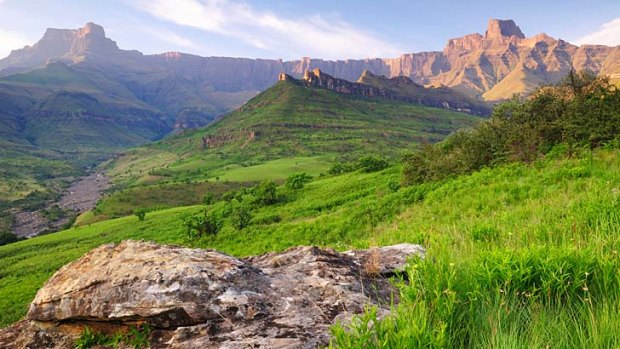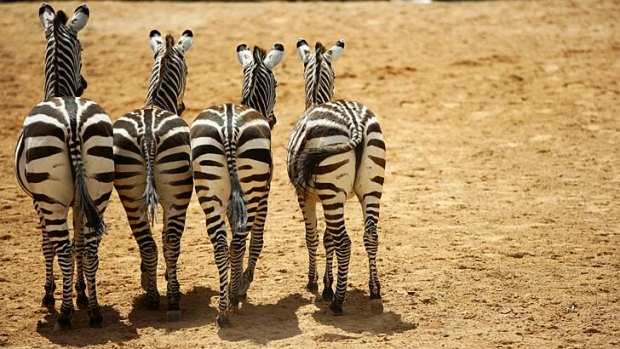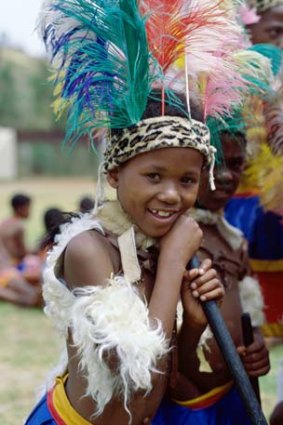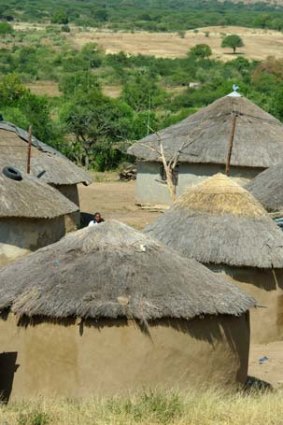
Rugged frontier ... the Drakensberg Mountains in Royal Natal National Park.Credit: Getty Images
Childhood fantasies of leopards and warriors come to life when Brian Johnston takes a road trip in KwaZulu-Natal.
How peculiar that South African travel brochures are filled with photos of well-dressed, good-looking people smirking like hyenas from safari jeeps. I find myself covered in dust with my hat awry as we lurch through potholes. I'm certainly not smiling. I'm even trying not to breathe. The brochures have failed to mention that zebras have a flatulence problem, but come within cooee of their striped haunches and it's a lesson soon learnt.
Ranger Louwrina Beyers is amused. She hoots and hollers like a teenage delinquent as the zebras gallop off, their muscled, flamboyant buttocks farting as they go.

Beware the flatulent zebras.Credit: Getty Images
Moments later Beyers is teary-eyed as we spot the Lone Ranger, a dishevelled old wildebeest hoofed from the herd to live his retirement years alone and palely loitering. The lions haven't picked him off yet, but it's only a matter of time, she says with a sigh. "At least he's had his life. Those poor warthog piglets, they're a lion's favourite snack. One gobble and they're a goner."
In South Africa, private game reserves are usually highly managed experiences, accompanied by rangers programmed in polite chit-chat. Makakatana Bay Lodge - on St Lucia Lake in the World Heritage iSimangaliso Wetlands of KwaZulu-Natal's north coast - isn't one of them. Makakatana is a modest place, ragged around the edges, friendly and satisfying. The wildlife hasn't yet become used to jeeps being around. Animals don't pose politely when cameras click, they fart in alarm and flee. I've seen the rear ends of leggy giraffes teetering away like runway supermodels wearing animal-print pants; admired red-billed oxpeckers on the retreating backsides of matronly buffalo; and, as for baboons, they have bums of blue and red bulges, like a frightful Picasso nude.
The baboon's bums make Beyers blush. She's new to the job, with the awkward but endearing enthusiasm of youth, and her wildlife knowledge is impressive. Did I know zebras have inefficient digestive systems? I did not, though this might explain their flatulence and distinctive, grassy droppings. I tuck away the useful word "caecum" (well developed in a zebra) so I can annoy my family when playing Scrabble.

A Zulu boy in traditional costume.Credit: Alamy
As we lumber back to the lodge, lanterns have been lit in the trees and cicadas are humming a welcome. We dine outdoors on curry prepared by a chef named Rejoice whose teeth shine out of the darkness. Night comes with a burping of frogs, a Swarovski display of stars and a slow ooze of contentment.
I'm on a rollicking boys' own adventure that began 30 years ago, in a sense, when I endlessly leafed through my grandfather's encyclopaedias, scattered with pictures of Zulu warriors and elephants and cricket clubs in places with siren names such as Tanganyika and Swaziland. Until I grew old enough to realise their world no longer existed, I wanted to be Rider Haggard, R.M. Ballantyne and Henry Morton Stanley.
Travel is as much about imagination as reality. It isn't just the promising brochure photos that lure us, but a lifetime of novels, movies and dreams. Europe in the 1970s, where I grew up, seemed dull as black-and-white television. Africa was a full-colour explosion where you could collect orchids, chase antelope and unearth diamonds. And so I'm lured to KwaZulu-Natal just because this is where Allan Quartermain makes his start at the opening of King Solomon's Mines. The rugged eastern province is squeezed between the Drakensberg Mountains and the Indian Ocean and is probably the closest I'll ever come to my childhood fantasy. It has great swatches of turtle-haunted coastline, swamps psychedelic with flamingos and magnificent game reserves where leopards lurk in thickets a gasp away from passing jeeps.

Zulu homes in KwaZulu-Natal.Credit: Alamy
Big wildlife and big landscapes are everywhere, but this is also the heart of Zululand, crammed with the legendary battlefields whose names dot my grandfather's books. As I drive inland from Makakatana, the conical huts belonging to farmers are scarcely different from those in the old picture books. Passing women flaunt a kaleidoscope of cotton as they haul baskets of corn on their heads. Boer folk trundle past in battered trucks, as blue-eyed and white-shirted as Mormons.
My first battlefield stop is Blood River, where in 1838 a Boer victory opened the area to white settlement. Sixty-four wagons cast in bronze re-create the Boer "laager" that defeated the Zulu army. It's a strangely haunting and isolated place, surrounded by grassland where the wind sighs. Isandlwana is more dramatic: whitewashed monuments to the fallen litter the battlefield under a vast outcrop of rock and great cotton-ball clouds. The British were trounced by a Zulu regiment at Isandlwana in 1879. A few hours later at nearby Rorke's Drift came a stirring tale of redcoat heroism when a motley force of 141 British soldiers held off 3000 Zulu warriors in a battle that lasted 122 hours. An excellent museum built around the original farmhouse recounts the tale. I expect to meet Michael Caine in a pith helmet, valiant in the face of assegai spears. Instead, there's only wilted English couple Terry and Anne, tiptoeing past the displays in post-colonial embarrassment.
By the second evening I'm in Ladysmith, where the British held out for 118 days, this time against the Boers in 1899. It's a comfortable, scruffy, energetic town with whitewashed colonial buildings and a mosque.
Next morning, I fill up on petrol in preparation for my final adventure into the Drakensberg Mountains that define the western border of KwaZulu-Natal.
As I drive towards Bergville, I can only stare through my windscreen at what the Zulus call the Barrier of Spears. Jagged peaks rear up in the distance, dwarfing neat fields and villages beneath. Roadside, women are dressed bright blue, fields are of a startling green and passing yellow utes are folk-art scenes come to life.
I'm soon driving into Royal Natal National Park, tiny on a map but compensated by soaring skywards in a series of tabletop mountains where waterfalls tumble, giving birth to what becomes the mighty Tugela River. Parking the car, I follow a riverside path. Strange-looking antelope lurk in the bushes and eagles float overhead as I climb a heart-thumping trail that brings me into a vast amphitheatre of cliffs where views tumble away to far plains.
The mountains are nothing like the Sheba's Breasts of Quartermain's treasure map, but I'm still surrounded by derring-do scenery. Unfortunately, as I continue my drive, my hunt for a meal doesn't provide quite the same thrill. I resort to ordering a margarita in an isolated restaurant called the Leaning Tower of Pizza, abashed at the ignominy of 21st-century tourism. I'd rather be shooting a warthog for the pot like a Victorian-era adventurer.
Next day, a two-hour drive north is spectacular all the way over the Oliviershoek Pass and through coyly named Little Switzerland. Almost everywhere in KwaZulu-Natal, the getting there has been as great a pleasure as the destination: the very definition of a good driving holiday. By afternoon, I'm walking in Golden Gate Highlands National Park, a fantasy of eroded sandstone hills, where startling red cliffs compete with vivid green hills for attention. Later, the fading sun turns the cliffs to fire as herds of antelope graze beneath. Dusk falls as I drive into the little Boer town of Clarens, pretty with weekend cottages fronted by white rose bushes. I've arrived in the Free State, where knitwear, artist retreats and scone-serving cafes take over.
Maybe they have those in KwaZulu-Natal, too, but not in my mind. Sometimes travel is just about giving in to the dream. Let me be a kid again, agog with the wonder of Africa. Allow me to swash my buckle, and bring on the farting zebras.
Brian Johnston travelled courtesy of the South African Tourism Board.
FAST FACTS
Getting there
South African Airways has a fare to Durban from Sydney and Melbourne for about $2356 low-season return, including tax. Fly Qantas to Perth (about 4hr), then to Johannesburg (11hr 30min), then to Durban (70min); see flysaa.com.
Staying there
Protea Hotel Clarens is a contemporary hotel with views over the Maluti Mountains. Rooms from 720 rand ($90) a person, twin share. See .
Hotel Izulu, just east of Durban, has rooms from 1500 rand a night. See hotelizulu.com.
Makakatana Bay Lodge has individual cabins from 2600 rand a person, twin share. Price includes all meals and
safaris. See makakatana.co.za.
More information
See southafrica.net.
Sign up for the Traveller Deals newsletter
Get exclusive travel deals delivered straight to your inbox. Sign up now.